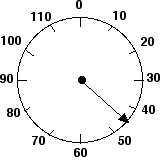Information is often provided in the form of tables. These can be quite complex and need careful reading.
Measurements are often made using scales.
Tables
Open any newspaper or magazine and you will probably find a table of information.
Below is a table of temperatures around New Zealand. It consists of headings and sub-headings and care must be taken when reading information from tables
|
Yesterday
|
Today
|
Tomorrow
|
|||||||
|
HIGH
|
LOW
|
HIGH
|
LOW
|
HIGH
|
LOW
|
||||
| Gisborne |
fine
|
13°
|
4°
|
fine
|
14°
|
5°
|
fine
|
12°
|
6°
|
|
Napier |
fine
|
14°
|
7°
|
fine
|
15°
|
6°
|
cloudy
|
15°
|
7°
|
| New Plymouth |
fine
|
12°
|
4°
|
fine
|
13°
|
5°
|
cloudy
|
12°
|
6°
|
| Wellington |
cloudy
|
14°
|
4°
|
rain
|
14°
|
5°
|
fine
|
13°
|
6°
|
| Nelson |
fine
|
12°
|
7°
|
fine
|
11°
|
5°
|
fine
|
13°
|
7°
|
| Blenheim |
fine
|
13°
|
6°
|
fine
|
14°
|
7°
|
fine
|
12°
|
5°
|
| Christchurch |
fine
|
10°
|
4°
|
cloudy
|
13°
|
5°
|
rain
|
12°
|
6°
|
| Queenstown |
fine
|
5°
|
1°
|
cloudy
|
10°
|
4°
|
rain
|
12°
|
3°
|
| Dunedin |
cloudy
|
12°
|
4°
|
rain
|
13°
|
6°
|
fine
|
12°
|
5°
|
| Invercargill |
rain
|
13°
|
5°
|
cloudy
|
14°
|
5°
|
fine
|
12°
|
4°
|
One column does not even have a heading. We assume it is talking about the weather conditions.
We assume also that the temperatures are given in degrees centigrade. In some countries temperatures are measured in degrees fahrenheit.
Another feature to notice are that the towns and cities are arranged in order from the north of New Zealand and move towards the south. This makes information easier to find.
Scales
Measuring devices often use scales . Readings from scales have to be estimated
. Readings from scales have to be estimated
The scale below shows the depth of a SCUBA diver in metres.

The reading is approximately half way between 40 and 50 i.e. 45 metres.
Modern appliances often have a digital electronic reading 